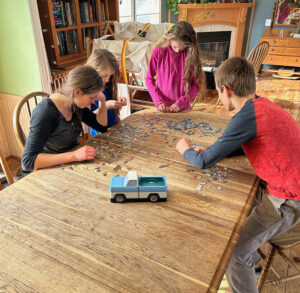MARYJANE’S EVERYDAY ORGANIC
Most of us regard our closets, drawers, and storage nooks as sacred personal space, so it’s a rude awakening when these private places are invaded — particularly when we find that the intruders have been boring holes through our wool, cashmere and other beloved fabrics. You know the culprits. Small and seemingly benign with their harmless fluttery wings, clothing moths can wreak havoc on a wardrobe before you even realize what you’re up against. Not even bedding, flooring or curtains are safe.
Such desperate times do, indeed, call for desperate measures. The trouble is, desperation often causes us to reach for the first available commercial product that promises to solve the problem. In the case of clothes moths, the common “cure” has long been mothballs. They’re easy to come by, and because they’re so common, it’s easy to assume they’re the best defense. But there is a definite downside to convenience. That pungent odor that we associate with moth-free closets is actually pesticide vapor. Mothballs are little nuggets of hazardous fumigants such as naphthalene, which destroys red blood cells (particularly in children and pregnant women), and p-dichlorobenzene, which can damage organs and induce anemia. Not the kind of stuff you want permeating your clothing.
The good news is that there are other options, better options. And the more we turn to alternative solutions, the less “alternative” they will become! In the case of clothes moths, the first step in dealing with the problem is to arm yourself with a little knowledge about your adversary.

Do You Have a Moth Problem?
The sight of a moth in your home is not necessarily cause for panic. Most of the moths we see are not clothes-consuming varieties. According to Bruce Walsh, professor of ecology and evolutionary biology at the University of Arizona, there are some 15,000 moth species in the United States, and only two feast on fabric. Because clothing moths prefer to hang out in dark, undisturbed corners of houses, we’re even less likely to spot them. Their telltale holes are often the first sign of infestation. Adult moths, which are about a quarter-inch wide and dull brown in color, lay eggs that hatch their fabric-eating larvae. The 1/2 inch caterpillars spend about 10 days fattening up on animal fibers they find. Wool, fur, silk, feathers (down), natural felt and leather are all on the menu. Other signs that clothing moths may have invaded your home are small web cocoons within folds of fabric, in corners, or at the junction of walls and ceilings. For photos and identification information, visit
the Colorado State University Extension Web site at www.ext.colostate.edu/PUBS/INSECT/05599.html.
Clean Up and Clear Out
Meticulous cleaning is the best line of defense against clothing moths. The moths, along with their eggs and larvae, can be killed by laundering fabrics in a 120-degree wash cycle. Be sure to wash clothing or other materials from second-hand shops before putting them away because they may bring moths into your home. Even though moths don’t generally eat cotton and synthetic materials, they may lay eggs in them, so wash everything to be safe. For fabrics that can’t be washed in hot water, freeze the fabric for two weeks to effectively kill larvae and eggs.
Once you have cleared out closets and drawers, vacuum them thoroughly, making sure not to miss the corners, to remove any remaining eggs and larvae that may remain. It’s also a good idea to vacuum along baseboards, underneath furniture, and inside vents where dust tends to accumulate and may attract moths.
Whether you’ve found moths in your home or not, it’s wise to store animal fiber materials in dry, airtight containers or sealed bags to keep moths at bay.
Natural Repellents and Traps
Contrary to popular belief, cedar closets or chests alone are not going to mothproof your home because they don’t maintain an effective concentration of cedar oil to bother the moths. Fresh, aromatic cedar chips in a mesh bag or an absorbent cloth soaked with cedar oil (try www.mountainroseherbs.com) can help repel or even kill moths if stored with clothing in an airtight container. Sachets of lavender, rosemary, vetiver, rose petals and dried lemon peel can also deter moths if kept fresh and pungent in sealed storage spaces.
Natural attractant traps called pheromone moth traps lure male clothing moths to sticky strips that emit mating pheromones. They can be used to trap existing moths or to monitor those places in your home that might be vulnerable. These non-toxic traps don’t kill eggs and larvae, but they do attract and kill male moths, putting a dent in reproduction. Buy USA-made traps online at www.Eartheasy.com.
































